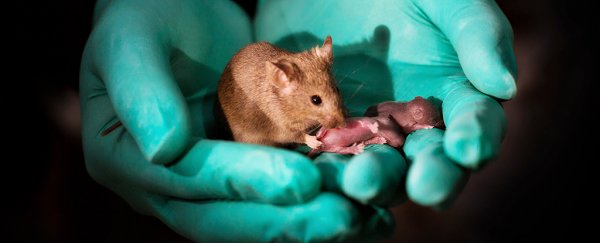By deleting key sequences of DNA in embryonic stem cells harvested from female mice, Chinese researchers successfully kicked off a new generation of the tiny mammals without the need for males to fertilise any eggs.
These fatherless mice not only made it to adulthood, they also went on to have babies of their own, demonstrating the method is a vast improvement on earlier attempts to assist reproduction without the need for both a male and female parent.
Biologists from the Chinese Academy of Sciences used a special editing technique on male- and female-derived 'haploid' embryonic stem cells (ESCs). These are effectively blank-slate cells that contain just half of a species' chromosomes, not unlike tissues associated with the production of sex cells.
Reproduction without the need for sperm – a process called parthenogenesis – is nothing new in the animal kingdom. Many insects can pop out clones of their mother. So can a number of fish. There are even lizards and amphibians without daddies.
Mammals, on the other hand, drew the short straw when it comes to creative means of having babies.
"We were interested in the question of why mammals can only undergo sexual reproduction," says the study's co-senior author Qi Zhou.
It was already well known that specific genes were epigenetically silenced during the development of those 'blank' stem cells in mammals, with the genes depending on whether the cells came from the mother or the father.
This process of 'genomic imprinting' means that combining a half-dose of genetic material from just two eggs or two sperm runs the risk of having both copies of an essential gene silenced - something we definitely don't want in single-sex parent situations.
In 2004, Japanese researchers successfully navigated their way around this hurdle by selecting a maternal set of chromosomes that contained the fewest imprints.
This sperm-analogue was then used to fertilise a typical ova, making a mouse with two mothers which they named Kaguya, after a fairy-tale character.
As effective as this technique was in the end, it left a lot to be desired as far as efficiency and reliability.
"The generated mice still showed defective features, and the method itself is very impractical and hard to use," says Zhou.
Years later, genetic editing technology has improved to the point that researchers can now selectively edit these imprint regions.
The research team cultured haploid ESCs from female mice to have minimal levels of genomic imprinting.
"We found in this study that haploid ESCs were more similar to primordial germ cells – the precursors of eggs and sperm," says Baoyang Hu, also a co-senior author on the study.
They then deleted three specific imprinted regions on the stem cells' chromosomes, effectively 'erasing' their imprinting. These 'female sperm' were then implanted into healthy donor cells to fertilise them.
The process is still far from flawless. Of the 210 embryos produced this way, only 29 live mice were born. But those that made it lived to maturity and had their own litters of pups, this time the old-fashioned way.
But the news wasn't so good for achieving motherless babies from male-only mice. In a similar process, seven imprinted regions were edited in haploid ESCs taken from male mice.
These were then injected into an ova that had its maternal chromosomes removed, and combined with DNA from an unedited sperm cell; the embryo was then implanted into a surrogate mother. Sadly, twelve pups were born, but none made it past the first 48 hours.
If we're hoping to apply any of this to assisted reproductive technologies for humans, we've still got a long way to go. Not just practically, but ethically.
"If the research is reproducible, and also works in humans, it still has to be shown to be safe," says Bob Williamson, the Chair of the Board of Stem Cells Australia, who wasn't involved in the research.
"The experiments are, however, important, because they may shine a light on some causes of serious handicap in children."
This is still one monumental step forward in understanding mammalian development and laying the groundwork for new medical processes.
"This research shows us what's possible," says co-author Wei Li.
"We saw that the defects in bimaternal mice can be eliminated and that bipaternal reproduction barriers in mammals can also be crossed through imprinting modification."
This research was published in Cell Stem Cell.
